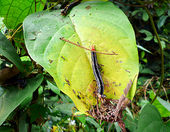
In early January, when the long, black caterpillars reached the creeks that serve as the main water sources for the town of Belefanai in north-central Liberia, the creatures' feces instantly turned streams dark and undrinkable.
Moving through the forest canopy on webs, devouring the leaves as they went, the caterpillars advanced like nothing the townspeople had ever seen.
They ate food and cash crops - coffee, cocoa, citrus, plantain, banana, and cassava. They took over homes and people fled.
Venturing into the forest meant being hit by a wave of caterpillars that appeared to be moving forward about as fast as the average person walks.
"The worms would drop on you from all angles," said Moses M. Kolinmore, a mason who arrived in Belefanai just as townspeople realized they had to get word to the government.
"They would cover the whole ground - thousands upon thousands of thick, strong, stubborn worms. It was fearful, very fearful."
The outbreak, which began in December in a remote, forested region of Guinea just over the border from Belefanai, has affected an estimated half million people in more than a hundred towns and villages, prompting the Liberian government to declare a state of emergency.
This week entomologists identified the insect as a moth with a name only scientists had heard before: Achaea catocaloides.
A New Pestilence
The caterpillar is not, as first suspected, the African army worm, a creature well-known for infesting huge regions of East Africa.
Instead, it is a similar brownish "noctuid" caterpillar/moth that has never before been reported as a widespread pest in Liberia but annually plagues parts of nearby Benin.
Government officials and international experts are searching for a strategy to control the outbreak, which threatens to spread because first -generation Achaea caterpillars are dropping to the ground and turning into pupae, then moths.
The moths can fly long distances - up to 620 miles (1,000 kilometers) if the winds are right - and then lay eggs that will hatch into still more caterpillars. Each moth not killed will lay 500 to 1,000 eggs and start the cycle again.
Johnson Nyelartah, a teacher in Belefanai, said townspeople are bracing for another worm invasion, "It is our fear that these butterflies will multiply [into] more than we had before," he said.
One cause for optimism: The caterpillars and moths are dry-season pests, and Liberia's dry season should last only another month or so, experts say.
"We are hoping the rains will end the outbreak," said J. Qwelibo Subah, director general of Liberia's Central Agricultural Research Institute (CARI), who is coordinating the response to the infestation.
Unappealing Options
In the interim, the Ministry of Agriculture is scrambling for solutions.
Fifty-five field staff are scouting for concentrations of the caterpillars and moths, spraying them with pesticide from the ground and collecting and burning the pupae in their cocoons. Farmers have been setting slow-burning fires in leaf litter to smoke caterpillars out of trees and incinerate them.
Because the caterpillar infests wide areas so rarely, scientists have not researched a way to safely and selectively kill large numbers of Achaea catocaloides.
If all other measures fail, Subah said, he would not rule out aerial spraying, even though UN Food and Agriculture Organization (FAO) officials have advised against the technique, because it would kill many other species and further contaminate open water supplies.
"We are considering all options," Subah said.
Why Now?
There's a lot about this outbreak experts still don't understand - making it impossible to say for certain how it can be stopped.
For starters, no one is sure what turned Achaea catocaloides - one of the most common moths across central and West Africa - into a nightmarish plague in Liberia's forest.
It could have been the weather, experts say.
During the dry season, a strong wind called the harmattan blows from the Sahara across West Africa. Perhaps in late 2008, this wind picked up Achaea catocaloides moths and then deposited a large concentration along the Guinea-Liberia border.
Or perhaps there was an unnoticed local increase in Achaea catocaloides numbers and, when the temperature was right, the population exploded, said Gregory Tarplah, an entomologist with Liberia's Ministry of Agriculture.
Whatever happened, once the caterpillars emerged in great numbers they needed an expanded food supply.
They turned from eating their favorite food, the Dahoma tree, to eating most any tree in their path. And they began to migrate in search of more.
Desperate Measures
To provide uncontaminated water to communities overrun with the worms, the Liberian government is fixing broken hand pumps, digging wells, and installing new pumps.
It's barely enough, Tarplah said. In Belefanai, for example, thousands of people depend on just three wells with hand pumps.
"People get on line in the morning, and then sometimes at two or three in the afternoon they get water," Kolinmore, the mason, said. "Sometimes the well runs out of water."
If water is in short supply now, food will be later in 2009.
Already this year's rice harvest will be smaller than usual. Swarms of worms along the paths into the forest kept farmers home during the crucial time when they usually cut and burn fields to grow the staple crop.
"The next season will be the hungry season," Kolinmore said.



Reader Comments
to our Newsletter